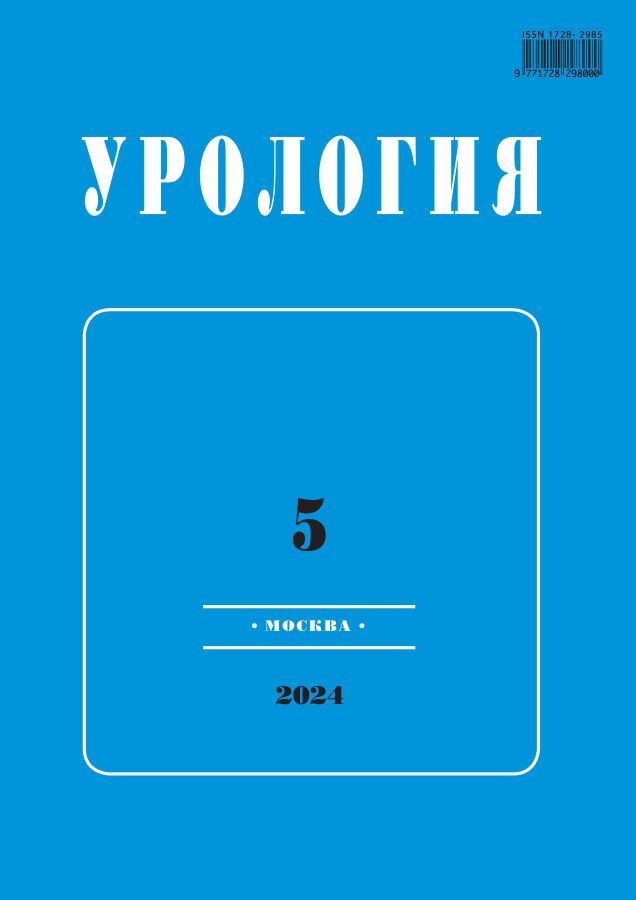The TG/HDL ratio as a marker of dyslipidemia among patients on maintenance hemodialysis. A cross-sectional study
- 作者: Hayder A.1, Zaid D.1, Sara H.1, Zainab A.1, Zinelabidin S.1
-
隶属关系:
- University of Basrah
- 期: 编号 5 (2024)
- 页面: 97-101
- 栏目: Uronephrology
- URL: https://journals.eco-vector.com/1728-2985/article/view/642279
- DOI: https://doi.org/10.18565/urology.2024.5.97-101
- ID: 642279
如何引用文章
详细
Background and objectives: Dyslipidemia is prevalent among patients with chronic kidney disease on maintenance hemodialysis. A high LDL is a known indicator of major adverse cardiovascular outcomes, but levels may be affected by malnutrition. A high TG/HDL ratio is another indicator of hard cardiovascular outcomes that should be sought carefully.
Patients and Methods: This was a cross-sectional study conducted on 111 patients on maintenance hemodialysis attending the hemodialysis unit at Basrah Nephrology and Transplantation Center at Al-Sader Teaching Hospital from September 1, 2022, to March 1, 2023. A high LDL is defined as > 60 mg/dl, and a high TG/HDL ratio is defined as >2.
Results: Among 111 patients with CKD on maintenance hemodialysis, high LDL was prevalent in 59.1%, and high TG/HDL ratio in 64.5%. Their mean ages were 52.6±15.7 years, 51.4% were males, and their BMIs were 25.2±5.6. Thirty-nine patients (35.1%) were on Aspirin (ASA), 49 patients (44.1%) were on Statins, eight patients (7.2%) were on Fibrate, and 11 patients (9.9%) were on Omega-3 fatty acids. No correlations were found between serum LDL and serum TG/HDL ratio with clinical and laboratory characteristics. A non-linear correlation between serum LDL and TG/HDL ratio was reported.
Conclusions: A high TG/HDL ratio should be sought and addressed carefully among patients with CKD on maintenance hemodialysis, as low LDL may be misleading in those populations.
关键词
全文:
作者简介
Aledan Hayder
University of Basrah
编辑信件的主要联系方式.
Email: Hayder.aledan@uobasrah.edu.iq
ORCID iD: 0000-0002-5938-1421
MD, FASN, College of Medicine, Department of Medicine, Division of Nephrology
伊拉克, BasrahDavid Zaid
University of Basrah
Email: zaid.david.med1718a@bjes.edu.iq
Students, College of Medicine
伊拉克, BasrahHaider Sara
University of Basrah
Email: sarah.haider.med1718a@bjes.edu.iq
Students, College of Medicine
伊拉克, BasrahAlmosawi Zainab
University of Basrah
Email: zeinab.iyad.med1718a@bjes.edu.iq
Students, College of Medicine
伊拉克, BasrahSaleh Zinelabidin
University of Basrah
Email: zain.al-abideen.ali.med1718a@bjes.edu.iq
Students, College of Medicine
伊拉克, Basrah参考
- Hill NR, Fatoba ST, Oke JL, Hirst JA, O’Callaghan CA, Lasserson DS, et al. Global Prevalence of Chronic Kidney Disease - A Systematic Review and Meta-Analysis. PloS One. 2016;11(7):e0158765.
- Mesquita J, Varela A, Medina JL. Dyslipidemia in renal disease: causes, consequences and treatment. Endocrinol Nutr Organo Soc Espanola Endocrinol Nutr. 2010;57(9):440–8.
- Lee C, Park JT, Chang TI, Kang EW, Nam KH, Joo YS, et al. Low-density lipoprotein cholesterol levels and adverse clinical outcomes in chronic kidney disease: Results from the KNOW-CKD. Nutr Metab Cardiovasc Dis. 2022;32(2):410–9.
- Gluba-Brzozka A, Franczyk B, Rysz J. Cholesterol Disturbances and the Role of Proper Nutrition in CKD Patients. Nutrients. 2019;11(11):2820.
- Lv S, Zhang H, Chen J, Shen Z, Zhu C, Gu Y, et al. The effect of triglycerides to high-density lipoprotein cholesterol ratio on the reduction of renal function: findings from China health and retirement longitudinal study (CHARLS). Lipids Health Dis. 2021;20:110.
- da Luz PL, Favarato D, Faria-Neto JR, Lemos P, Chagas ACP. High ratio of triglycerides to HDL-cholesterol predicts extensive coronary disease. Clin Sao Paulo Braz. 2008;63(4):427–32.
- Pontremoli R, Bellizzi V, Bianchi S, Bigazzi R, Cernaro V, Del Vecchio L, et al. Management of dyslipidaemia in patients with chronic kidney disease: a position paper endorsed by the Italian Society of Nephrology. J Nephrol. 2020;33(3):417–30.
- Kim Y, Lee S, Lee Y, Kang MW, Park S, Park S, et al. Predictive value of triglyceride/high-density lipoprotein cholesterol for major clinical outcomes in advanced chronic kidney disease: a nationwide population-based study. Clin Kidney J. 2020;14(8):1961–8.
- Hajian-Tilaki K, Heidari B, Bakhtiari A. Triglyceride to high-density lipoprotein cholesterol and low-density lipoprotein cholestrol to high-density lipoprotein cholesterol ratios are predictors of cardiovascular risk in Iranian adults: Evidence from a population-based cross-sectional study. Casp J Intern Med. 2020;11(1):53–61.
- Makówka A, Dryja P, Chwatko G, Bald E, Nowicki M. Treatment of chronic hemodialysis patients with low-dose fenofibrate effectively reduces plasma lipids and affects plasma redox status. Lipids Health Dis. 2012;11:47.
- Fazelian S, Moradi F, Agah S, Hoseini A, Heydari H, Morvaridzadeh M, et al. Effect of omega-3 fatty acids supplementation on cardio-metabolic and oxidative stress parameters in patients with chronic kidney disease: a systematic review and meta-analysis. BMC Nephrol. 2021;22:160.
- Lipid metabolism disorders and bone dysfunction-interrelated and mutually regulated (Review) - PMC [Internet]. [cited 2023 May 13]. Available from: https://www.ncbi.nlm.nih.gov/pmc/articles/PMC4438959/
补充文件









